Gallery opened: Mar 2001
Updated: 2 July 2016
More info, links to duplex-drive




Petiet's French Experiments. |
Gallery opened: Mar 2001 |
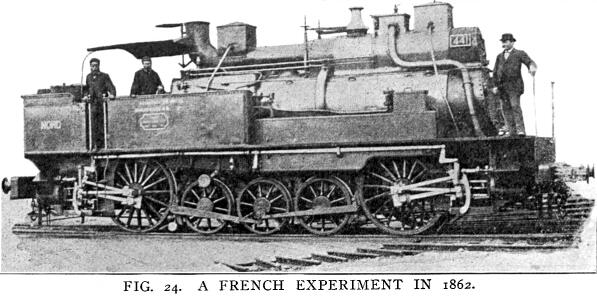
| Left: The experiment of M. Petiet.
"Hey, mister, that's me up on the smokebox..."
That's M. Petiet on the right.
Eight of these duplex-drive engines were built, which proved to be eight too many.
The number on the smokebox is "441". (white figures on black ground)
|
Most of the information below was kindly provided by C. Bersano, to whom I am most grateful.
THE LOCOMOTIVE
The idea behind the Locomotive Petiet A111A was to double the output of a Crampton-type locomotive, but without coupling together two driving axles. Apparently at the time coupling rods were not considered strong enough to handle high speeds. Hence there are independent driving wheels and cylinders at each end, while the smaller wheels in the middle just carry part of the weight. The amount of this weight available for adhesion must have been limited.
The long drum on top of the boiler is a steam dryer, not a feed heater, which accounts for the presence on top of it of a little box that presumably holds the regulator, just behind the forward sand container. The chimney runs through the dryer, and exhausts just ahead of the cab. There is swivelling cover for this chimney; this was known in French practice as the capuchon (cap) and was used as a draught damper as well as to keep the rain out.
There was no feedwater heater and no injectors. The boiler was fed by a pump powered from one of the driving axles.
The two big square boxes are clearly for sand, and there seems to be no steam-dome as such, the dryer presumably rendering this redundant. From the regulator box a large pipe appears to feed steam to the forward cylinders. Behind this a conical thingy holds two Salter safety valves.
The name of the railway "Nord" can be read at the rear.
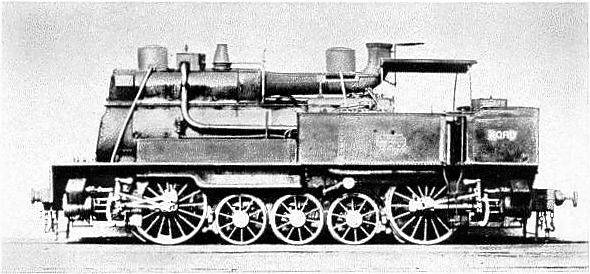
| Left: The other side of the experiment of M. Petiet. It is not clear if this is No 441 or another one of the series.
|
A FEW NUGGETS OF DATA...
Grate area:2.63 sq m
Boiler tubes:19 of 80mm diam
Constructor:Gouin of Paris |
THE DESIGNER
Jules Petiet (1813-1871). Petiet's main claim to fame was the introduction to the Nord of the Belpaire firebox, with a wide grate capable of burning small pieces of coal. Petiet made a 0-8-0, using a very similar boiler to the one above, which was a success, and a 0-6-0 + 0-6-0 non-articulated which did not last long and was cut into a more useful 0-6-0. These were tender locomotives.
Petiet died of apoplexy (presumably a stroke) on 29th of January, 1871
THE RESULTS
The boiler, with its steam dryer and looped-back chimney was a success; no problems were
encountered with the exhaust system, and steam production was adequate. But...
The aim was "grande vitesse", but as one critic put it: "Ce fut un fiasco complet!" which, I think, requires no translation.
Eight of these tank engines were built, numbered 437 - 444, but they proved unstable at the speeds they were constructed for, and suffered chronic axlebox overheating on the three idler axles. They were quickly relegated to branch line work. Date of withdrawal not currently known.
That's Petiet standing in front of the smokebox in the top picture.
For another Petiet duplex design, see: Strange Chimneys, elsewhere in the Locomotive Wing of The Museum of RetroTech.
AN EARLIER PETIET DESIGN #1: 186?

Left: No 162, named Alma. This Crampton-type engine was built in 1855, and converted to Petiet steam-drier form at some later date, probably in the 60's.
It was withdrawn and scrapped in 1873. I suppose this is a 6-2-0 configuration.
Crampton-type locomotives were invented by Thomas Crampton, (1816-??) an Englishman. They are distinguished by having a single driving axle behind the firebox, allowing large driving wheels, with correspondingly high axles, to be combined with a large boiler set low in the chassis. A low centre-of-gravity was held to be essential for stability- a perfectly reasonable conclusion, but as it happened, not actually correct. In the long term, this seems less important than Crampton's adoption of wide steam passages, generous bearing surfaces, and large heating surfaces, and it was these three features rather than the position of the driving axle that ensured the high-speed qualities of his locomotives. The first example was built at Whitehaven in 1846 for a Belgian railway. The type did not find favour in Britain or America, but was highly successful in France and the German states.
The great drawback of the Crampton concept was the relatively small amount of the locomotive's weight that was available for adhesion.
ANOTHER PETIET DESIGN #2: 1863
A class of 20 duplex 0-6-6-0 tank engines were built by Establissement Gouin in Paris.
The duplex drive is still in evidence here; a system that has rarely found favour anywhere. At best there are twice as many moving parts to maintain, at worst there can be real problems with wheelslip.
Another Petiet design, with a slightly more sensible wheel arrangement. At least all the weight is available for adhesion; unfortunately that did not make them a success, and in an extraordinary feat of modification all twenty were rebuilt into forty ‘Orleans’ type 0-6-0 tank engines for station pilot work at the company’s works at La Chappelle, in the period 1872 - 1874.
Note that a roof over the footplate is provided, which was unusual for the time. This was because the driver and fireman would otherwise have been working under a shower of hot cinders from the chimney.
Note that the blast pipe was horizontal, and apparently placed in the middle of the rearward-running flue.
Provenance of this elegant script unknown.
ANOTHER PETIET DESIGN #3: 1863
Here is duplex drive again. Note the horizontal blastpipe.
The only information given in Engineering is the caption on the picture. However, this has got to be a Petiet creation, and it is a valuable image as it is the only one I've found that shows the plumbing. It resembles #2 above, but note the differences in the chimney and coal bunker.
AND YET ANOTHER PETIET DESIGN #4: 18??
This may be the successful 0-8-0 referred to above. Nothing else known at present.
This version has no roof to protect the footplate staff; instead the chimney has been extended further to the rear.
PETIETS OUTSIDE FRANCE: SPAIN 1863
The locomotives were intended for use on severe gradients, but did not fulfil expectations. They exhibited bad steaming and poor riding qualities on curves, and had a very long rigid base, with only 15
mm sideplay at the extreme axleboxes. The small capacity of the side water tanks was also a problem. These locomotives were later integrated into the "Norte de España Railways" traction roster with numbers 801-802. This company withdrew and scrapped the "Petiets" around 1883.
Information kindly supplied by Santiago Gonzlez Estrada
Bibliography: "10 Décennies de Locomotives à Vapeur sur le Réseau du Nord"

Left: No 601 of the Nord, was the first example of this design; it was built in 1863 with nine others.
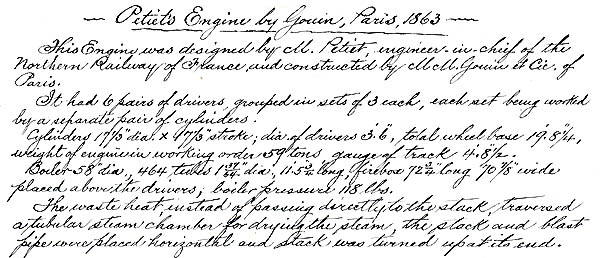
Left: Some technical details of No 601.
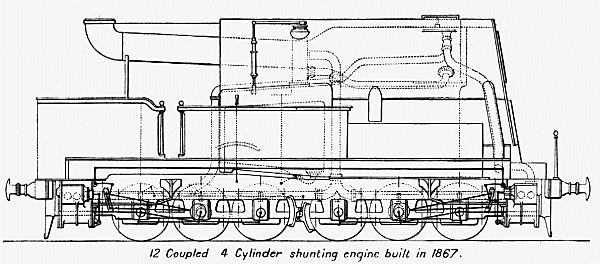
Left: A locomotive depicted in the British journal Engineering for June 20th, 1890.

Left: Another section of the #3 design locomotive.
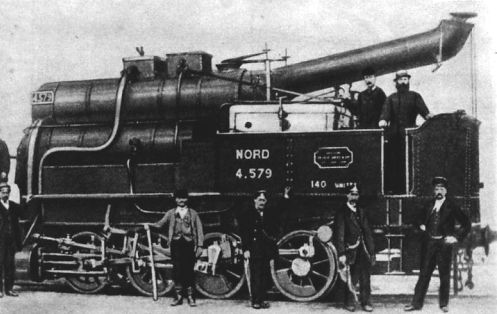
Left: No 4579 of The Nord, built in 18??. Another Petiet design, apparently an 0-8-0
The Zaragoza-Pamplona Railway Company of Spain bought two Petiet system locomotives from Gouin in 1863, which presumably closely resembled the 1863 design seen above. These were numbered FN 676, 677 (or possibly 646, 647) The axle layout was 0-3-0 + 0-3-0, with outside cylinders and Stephenson valve gear.
Wheel diameter was 1.065 m, with the power estimated at 628hp at 21 Km/h. The grate area was 3.33 m2.(very great for the time and not surpassed by another locomotive in Spain even in 1911)
by Lucien-Maurice Vilain, published in France in the 70's and now out of print.



